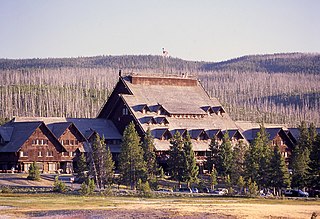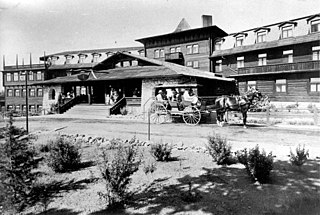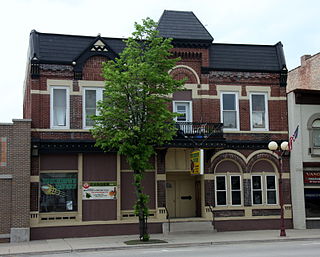
The Old Faithful Inn is a hotel in the western United States with a view of the Old Faithful Geyser, located in Yellowstone National Park, Wyoming. The Inn has a multi-story log lobby, flanked by long frame wings containing guest rooms. In the western portion of the park, it sits at an approximate elevation of 7,350 feet (2,240 m) above sea level.

Hotel Adolphus is an upscale hotel in the Main Street District of Downtown Dallas, Texas. A Dallas Landmark, it was for several years the tallest building in the state. Today, the hotel is part of Marriott Hotel's Autograph Collection.

The Brown Palace Hotel, now The Brown Palace Hotel and Spa, Autograph Collection, is a historic hotel in Denver, Colorado, United States. It is listed on the National Register of Historic Places and is the second-longest operating hotel in Denver. It is one of the first atrium-style hotels ever built. It is now operated by HEI Hotels and Resorts, and joined Marriott's Autograph Collection Hotels in 2012. The hotel is located at 321 17th Street between 17th Street, Broadway and Tremont Place in downtown Denver behind the Republic Plaza. The main entrance door is on Tremont Place.

The Ahwahnee is a grand hotel in Yosemite National Park, California, on the floor of Yosemite Valley. It was built by the Yosemite Park and Curry Company and opened for business in 1927. The hotel is constructed of steel, stone, concrete, wood, and glass, and is a premier example of National Park Service rustic architecture. It was declared a National Historic Landmark in 1987.

The Grand Hotel is a historic hotel and coastal resort on Mackinac Island, Michigan, a small island located at the eastern end of the Straits of Mackinac within Lake Huron between the state's Upper and Lower peninsulas. Constructed in the late 19th century, the facility advertises itself as having the world's largest porch. The Grand Hotel is known for a number of notable visitors, including five U.S. presidents, inventor Thomas Edison, and author Mark Twain.

The Driskill, a Romanesque-style building completed in 1886, is the oldest operating hotel in Austin, Texas, United States, and one of the best-known hotels in Texas generally. The Driskill was conceived and built by Col. Jesse Driskill, a cattleman who spent his fortune constructing "the finest hotel south of St. Louis".

The El Tovar Hotel, also known simply as El Tovar, is a former Harvey House hotel situated directly on the south rim of the Grand Canyon in Arizona, United States.

The Floridan Palace Hotel, formerly known as the Hotel Floridan or Floridan Hotel, is a historic hotel in Tampa, Florida, United States. It is located at 905 North Florida Avenue in the north end of the downtown core. It was designed by prominent Tampa architects G.A. Miller and Francis J. Kennard and built in 1926, opening in early 1927. On March 12, 1996, the Floridan was added to the U.S. National Register of Historic Places.

The Cincinnatian Hotel is a registered historic building in Downtown Cincinnati, Ohio, listed in the National Register on March 3, 1980. It is a member of the Historic Hotels of America, the official program of the National Trust for Historic Preservation. Since 2018, the hotel has been owned by SREE Hotels of Charlotte and the hotel has been managed by Hilton Worldwide and is part of its upscale Curio Collection brand.

Grand Canyon Depot, also known as Grand Canyon Railroad Station, was constructed in 1909–10 for the Atchison, Topeka and Santa Fe Railway at the South Rim of the Grand Canyon, in what is now Grand Canyon National Park. It is one of three remaining railroad depots in the United States built with logs as the primary structural material. The station is within 330 feet (100 m) of the rim of the canyon, opposite the El Tovar Hotel, also built by the railroad. The depot is designated a National Historic Landmark, is listed the National Register of Historic Places, and is included in the Grand Canyon Village National Historic Landmark District.

The Grand Canyon Lodge is a hotel and cabins complex at Bright Angel Point on the North Rim of the Grand Canyon. It was designed by Gilbert Stanley Underwood, who designed a number of other hotels in national parks for the Utah Parks Company and other concessioners. Built in 1927–28, the Grand Canyon Lodge resort complex consists of the Main Lodge building, 23 deluxe cabins, and 91 standard cabins, some of which were moved to the north rim campground in 1940. All guests are housed in cabins detached from the main lodge, which serves as a dining, concessions and service facility. Constructed of native Kaibab limestone and timber, the complex was designed to harmonize with its rocky and forested setting. The Grand Canyon Lodge complex is notable for its setting and rustic design, as well as its status as the only complete surviving lodge and cabin complex in the national parks.

Crater Lake Lodge is a hotel built in 1915 to provide overnight accommodations for visitors to Crater Lake National Park in southern Oregon, US. The lodge is located on the southwest rim of the Crater Lake caldera overlooking the lake 1,000 feet (300 m) below. The lodge is owned by the National Park Service, and is listed on the National Register of Historic Places. In 2022, the hotel is a Historic Hotels of America program member, and has been so since 2012.

The Battle House Renaissance Mobile Hotel & Spa, is a historic hotel in Mobile, Alabama. The current structure was built in 1908 as the Battle House Hotel. It is the second hotel by that name to stand in this location, replacing an earlier Battle House built in 1852, which burned down in 1905. It is one of the earliest steel frame structures in Alabama.

The Old Talbott Tavern, also known as the Old Stone Tavern, a historic tavern built in 1779, is located in the Bardstown Historic District of Bardstown, Kentucky, across from the historic Nelson County Courthouse. It was placed on the National Register of Historic Places on October 30, 1973.

The Hotel Beaumont in Beaumont, Texas, United States was built in 1922 by a group of 277 investors. One million dollars was spent to build the structure. The building is 11 stories tall, and has 250 rooms. The building contains two ballrooms, the Rose Room, and the Sky Room on the Roof, both of which were used many times during the structure's colorful history. It is on Orleans Street near Pearl Street.

Beastro & Barley, formerly Touchdown Tavern, Town Club Bar or Roper's City Hotel, is a restaurant and bar in a historic hotel building in the Second Empire style at 125 East Main Street in Reedsburg, Wisconsin, United States. The two-storey red brick structure with stone trim and a mansard roof was designed by Edward M. Hackett and constructed in 1886 for $10,000. It includes arched window frames, brick detailing on the facade and a small porch with ornamental metal balustrade on the second floor. It was listed on the National Register of Historic Places for Wisconsin in 1984. It was built by the Reedsburg Building & Lumber Co.

The Chieftain Hotel is a historic former hotel building at 38 Pearl Street in Council Bluffs, Iowa, United States. It opened in 1927, the result of a partnership between the Eppley Hotel Company and local patrons, and was built on the site of the Grand Hotel, which had opened in 1891 and was destroyed by a fire in 1925. The hotel was eight stories tall, and featured 153 guest rooms.

The Lincoln Hotel is a historic building located in Lowden, Iowa, United States. It was listed on the National Register of Historic Places in 1996. The Lincoln Highway was established in 1913 and passed through Lowden. This hotel was built in 1915 to accommodate the travelers that passed through town. Celia Clemmens, who operated the railroad hotel in town, and her husband A.F. Clemmens built and operated this hotel as well. The hotel is a two-story, rectangular structure with an exterior covered with pebble dash stucco. The shallow-pitched hip roof, wide eaves and the stucco finish reflect the influence of the Prairie School, while the Tuscan columns on the porch and crown window moldings reflect the Neoclassical style. Off the front porch the first floor housed a small lobby, guest parlor and dining room, and the owner's living quarters. The second floor housed the twelve guest rooms and two bathrooms. A first floor addition built in 1920 to increase the size of the owner's quarters has subsequently been removed. The Lincoln Highway in Iowa became U.S. Route 30 in the 1920s, and it was realigned in the mid-1950s just to the south of Lowden. The hotel was able to stay in business until 1981. The building sat empty for the next twelve years before it was converted into apartments from 1994 to 1995.
Aunty Green Hotel is a historic building located in Bonaparte, Iowa, United States. The hotel was built by John Green in 1844. His wife Mary continued to operate the hotel for many years after his death, and that what gave the business its name. It was the second hotel established in town, and it is believed to be the first brick building constructed in Bonaparte. Other businesses that have been housed in this building include a photography studio, doctor's offices, the first local telephone exchange, a creamery and a gas station. The Van Buren County Historical Association rescued the structure from demolition. It is currently owned by the Bonaparte Historical Society and houses the Auntie Green Museum and the public library.

The Ouray Historic District, in Ouray, Colorado, is a 114-acre (0.46 km2) historic district which was listed on the National Register of Historic Places in 1983. Many of the commercial buildings are Italianate in style; many residences are Victorian.





















